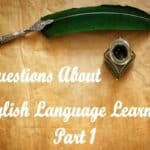| Sheltered Instruction Components and Features | Suggested Instructional Activities |
Lesson Preparation (LP) 1. Write content objectives clearly for students. | Incorporate listening, speaking, reading, and writing activities Realia, manipulatives, props, photographs, illustrations Demonstration of lesson procedures Videos, DVDs, CD-ROMs, audio tapes Adapted, taped, or highlighted text Teacher-prepared outlines Jigsaw activities Marginal notes High-interest, low-readability texts, Trade books Thinking Maps and other graphic organizers Bilingual dictionaries Native language texts |
Building Background (BB) 7. Explicitly link concepts to students’ backgrounds and experiences (“Have you ever…?) 8. Explicitly link past learning and new concepts. (Do you remember when we….?) 9. Emphasize key vocabulary (e.g., introduce, write, repeat, and highlight) for students. | Question Stems to elicit and share background experiences Classroom charts and posters to link prior learning to new learning Advance Organizers Videos, DVDs, stories, articles, books, pictures, or photographs Insert Method, Anticipation Guides Concept/Question Board Concept definition maps Word sorts, Vocabulary flip books Word generation activities Vocabulary Self-Collection Strategy (VSS), Personal dictionaries Cloze activities Mnemonic strategies Interactive word walls Labeling Word knowledge self-assessment, Word banks |
Comprehensible Input (CI) 10. Use speech appropriate for students’ proficiency level (e.g., slower rate, enunciation, and simple sentence structure for beginners). 11. Explain academic tasks clearly. 12. Use a variety of techniques to make content concepts clear (e.g., modeling, visuals, hands-on activities, demonstrations, gestures, body language). | Preview lesson topic; provide multiple exposures to key details Provide both oral and written directions for tasks Step by step explanation and modeling of tasks Display a finished product as an example Assess students’ comprehension often (“Tell your partner what to do.”, Thumbs up if you can repeat the directions”, etc.) Multimedia resources (music, overhead transparencies PowerPoint presentations, Web sites, videos/DVDs, etc.) Graphic organizers specific to the task Allow students to express understanding via alternative forms |
Strategies (S) 13. Provide ample opportunities for students to use strategies, (e.g., problem solving, predicting, organizing, summarizing, categorizing, evaluating, self-monitoring). 14. Use scaffolding techniques consistently (providing the right amount of support to move students from one level of understanding to a higher level) throughout lesson. 15. Use a variety of question types including those that promote higher-order thinking skills throughout the lesson (literal, analytical, and interpretive questions). | Rehearsal strategies Thinking Maps and other graphic organizers Text comprehension strategies (predicting, retelling. summarizing, etc.) QAR strategy Questioning the Author Anticipation / Reaction Guides Think-Alouds Note Taking (Three-Column, Cornell notes, etc.) Scaffolded Questions / Verbal scaffolding of student responses Question stems that promote higher-order thinking skills |
Check out the following link to access frequently asked questions on ESL and Bilingual Law in New Jersey.
https://hctutorial.com/esl-and-bilingual-frequently-asked-questions/
Free Sheltered Instruction Online Course
https://www.youtube.com/channel/UCL_e48z694tw9bqI1mUbHjg
Math and Language Arts Videos in Haitian Creole




Pingback: What is Sheltered Instruction? · hctutorial
Pingback: Who Does Sheltered Instruction Benefit?